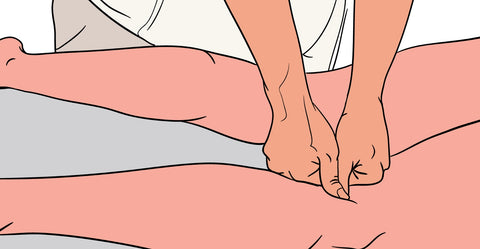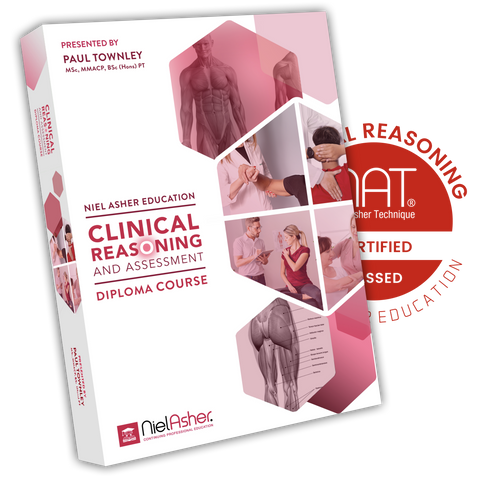Treating Plantaris | Trigger Point Release | Knee Pain | Calf Pain | Foot Pain

Trigger points in Plantaris are often associated with "unexplained" pain at the back of the knee
Trigger Points and Knee Pain - Overview
Any therapist experienced in treating trigger points will tell you that it's amazing how often a little bit of trigger point knowledge can help identify the cause of "unexplained" pain.
A good example is clients who come to us with pain in the back of the knee, sometimes radiating to the back of the calf, and in a few cases radiating all the way down to the big toe.
In these cases, the culprit is often the Plantaris muscle. This is a slim tendon running next to the larger Achilles Tendon.
It’s function is to work with the Achilles to flex the ankle and knee joint by extending from the outside back of the femur (allowing you to stand on your toes or point your foot).
The plantaris starts just above lateral head of the gastrocnemius muscle and runs beneath the gastrocnemius and soleus muscles located near the inner (medial border) of the Achilles tendon and attaches to medial side of the Calcaneus (heel bone).
Treating the Calf Muscles - Maureen Abson

Trigger Point Therapy - Treating Plantaris
Who is most at risk?
Trigger points in the Plantaris are extremely common especially in runners and those who play weekend sports such as soccer.
Over the years we've also noticed a definite connection with people who drive for long periods, and with the prologued wearing of high heels - especially in the case of women who are on their feet for long periods each day.
Two other important observations (and something we regularly hear from colleagues) is that trigger points in Plantaris seem also to be commonly associated with shin splints, and growing pains in children.

Plantaris Trigger Points - Often associated with "unexplained" knee pain
Trigger Point Therapy
Identifying trigger points in the Plantaris should be quite straightforward for any experienced therapist, and they are generally quite simple to treat.
If you fall into any the categories above (running, driving, prologued wearing of high heels) it is probably worth having a therapist check you for trigger points as these may exist for a while without showing any signs or symptoms.
Trigger points make their host muscle shorter and less efficient, so early treatment may often help to avoid the development of a more serious injury.
Trigger Point Self Help
General advice includes change footwear; change and vary running techniques/running surface; avoid high-heeled shoes where possible. Regular stretching. Leg rests at home and at work. Warm up before exercise and use ice and massage after sports.
Balls and pressure tools should not be used by the novice, because the muscle is deep and there are many both superficial and deep veins in the area.
One thing you can do however is to regularly stretch. the correct stretching exercises can be excellent for disabling trigger points in the lower limb and calf muscles.

Sit with your legs out in front and bend both knees. Grab hold of your toes and pull them towards your knees.
Regulate the intensity of this stretch by pushing your heels forward and pulling your toes back.

Kneel on one foot and place your body weight over your knee. Keep your heel on the ground and lean forward.
Be careful as this stretch can put a lot of pressure on the Achilles tendon. Ease into this stretch by slowly leaning forward.
Links
More articles about Shin Splints
More Articles About Trigger Points
Certify as a Trigger Point Therapist

Trigger Point Therapy Diploma Course

Clinical Reasoning and Assessment for Manual Therapists

JOIN NOW
EDUCATION MEMBERSHIP PLANS
UNLIMITED ACCESS
FROM $19.95/monthly
This trigger point therapy blog is intended to be used for information purposes only and is not intended to be used for medical diagnosis or treatment or to substitute for a medical diagnosis and/or treatment rendered or prescribed by a physician or competent healthcare professional. This information is designed as educational material, but should not be taken as a recommendation for treatment of any particular person or patient. Always consult your physician if you think you need treatment or if you feel unwell.
About Niel Asher Education
Niel Asher Education (NAT Global Campus) is a globally recognised provider of high-quality professional learning for hands-on health and movement practitioners. Through an extensive catalogue of expert-led online courses, NAT delivers continuing education for massage therapists, supporting both newly qualified and highly experienced professionals with practical, clinically relevant training designed for real-world practice.
Beyond massage therapy, Niel Asher Education offers comprehensive continuing education for physical therapists, continuing education for athletic trainers, continuing education for chiropractors, and continuing education for rehabilitation professionals working across a wide range of clinical, sports, and wellness environments. Courses span manual therapy, movement, rehabilitation, pain management, integrative therapies, and practitioner self-care, with content presented by respected educators and clinicians from around the world.
Known for its high production values and practitioner-focused approach, Niel Asher Education emphasises clarity, practical application, and professional integrity. Its online learning model allows practitioners to study at their own pace while earning recognised certificates and maintaining ongoing professional development requirements, making continuing education accessible regardless of location or schedule.
Through partnerships with leading educational platforms and organisations worldwide, Niel Asher Education continues to expand access to trusted, high-quality continuing education for massage therapists, continuing education for physical therapists, continuing education for athletic trainers, continuing education for chiropractors, and continuing education for rehabilitation professionals, supporting lifelong learning and professional excellence across the global therapy community.

Continuing Professional Education
Looking for Massage Therapy CEUs, PT and ATC continuing education, chiropractic CE, or advanced manual therapy training? Explore our evidence-based online courses designed for hands-on professionals.


















